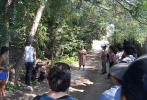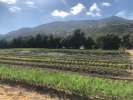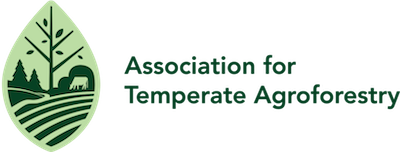| |
Hello Visitor,
Welcome to the Winter 2022 edition of the Temperate Agroforester!
The Winter 2022 Temperate Agroforestry focuses on agroforestry in the southwestern US and Baja California, Mexico. Special thanks for the guidance on this issue provided by guest co-editor James Allen.
Arid-Land Agroforestry
The southwestern United States and northwestern Mexico is a region of remarkable diversity. The landscape ranges from the lowest, hottest and driest deserts in North America to snow-capped peaks soaring well above 10,000 feet. While much of the land is not suitable for modern forms of agriculture, it includes some of the most productive farmland in the U.S. It is a culturally diverse region, with a large Indigenous population, people who can trace their roots to the earliest Spanish settlements, and many residents who have come to the region more recently from all over the U.S. and the world. In short, it is a fascinating region in which to practice agroforestry!
I'd like to thank all of those who contributed articles to this special issue of the Temperate Agroforester. My fellow authors and I appreciate the invitation to feature agroforesty in this region and we hope that you find this issue to be of interest, no matter where you happen to be as you read it.
Call for Articles: Spring 2022
We are pleased to announce the call for articles for the Agroforester Newsletter for Spring 2022. The theme for the Spring 2022 newsletter will be forest farming. Topics could include production, marketing, outreach, or simply sharing experiences with forest farming. If you have an interest in submitting an article relevant to the featured theme or any questions, please submit your article topic or any questions to afta_editor@aftaweb.org by March 9. Final articles will be due April 18. As always, we welcome ideas for future themes and suggestions for articles, and we welcome any input or feedback about the newsletter at afta_editor@aftaweb.org. Let’s share what each of us are doing and educate/encourage others out there to take advantage of agroforestry!
Membership
Are you interested in becoming a member of AFTA or need to renew? If so, get started by clicking here. Your membership gives you access to the members-only area, discounts on conference registration, and helps support AFTA's mission to promote agroforestry. If you have any questions about memebership please feel free to contact us at member@aftaweb.org.
Contents
Kat Alicia Thompson, Navajo
 In the summer of 2018, I was on a field trip studying Indigenous farming practices and had the pleasure of visiting Flowering Tree Permaculture Institute. Located in northern New Mexico in the Santa Clara Pueblo, Flowering Tree Permaculture Institute is a 30-year-old food forest that is on an ⅛ of an acre. While I waited for the tour to begin, I admired the vast differences of the cultivated landscape of the permaculture institute to the scenic high desert that surrounded it. On the outside of the miniature food forest, the harsh summer sun heated the earth. Vegetation was sparse, which exposed the compacted soil and ants crawled about.
As soon as I stepped into the food forest, I felt immediate relief under the cool shade. Vegetation exploded in every direction as I navigated along trees of varying sizes, mossy boulders, shrubs, flowers, and vines. At the center of the food forest is a hand built sustainable adobe house, with grape vines crawling up the walls. Shamelessly, our tour group stretched our necks out like giraffes and nibbled the sweet grapes off the wall of the home. We felt immersed in the environment and giggled with child-like joy at what the mini food forest had to offer.
Read More
Lindsey Hethcote- Education Director at Tres Estrellas Organic Farm and Garden
 Tres Estrellas Organic Farm and Garden is a 35-year old, 6-acre, organic production and educational farm located in Tecate, Baja California, Mexico, in a mountain valley amidst 240 acres of chaparral and oak woodlands. Tres Estrellas has served as the production farm for Rancho La Puerta Wellness Resort and Spa for over three decades, providing 60-80% of the produce used to prepare three farm-fresh meals a day for 5,000+ international guests annually. The fruits, vegetables, eggs, flowers, culinary herbs and goat milk that are produced on the farm are delivered, recently harvested, multiple times a week to the three commercial kitchens operated by Rancho La Puerta. The permaculture influenced farm incorporates biointensive fruit and vegetable production, agroforestry, agrobiodiversity conservation and animal husbandry to create a living example of ecological agriculture.
Read More
Katherine Favor, NCAT Sustainable Agriculture Specialist
 “Kill two birds with one stone” — isn't it time this old adage got an update? Instead of killing two birds with one stone, why don't we save two birds with one hedgerow? And protect soil from erosion while we're at it? And protect plants from wind damage, too? And do a bunch of other great things that benefit humans, animals, and the environment? When it comes to achieving multiple goals at once, conservation hedgerows are a shining example.
Read More
James Allen, School of Forestry, Northern Arizona University
 It may be surprising to some readers, but the Southwestern U.S. is a major producer of pecans. The 65,000 acres under production in New Mexico and Arizona, combined with high average yields per acre, help to make these two states the second and fourth largest pecan producing states in the U.S., respectively (USDA, 2020). Most of those acres are monocultures, with the ground kept largely bare using herbicides or mechanical weed control to facilitate harvesting (Figure 1). A notable exception is the seven acres of pecans managed by Frank Geminden in Camp Verde, Arizona. His approach is an example of pecan production that is also agroforestry.
Read More
Steve Price, Extension Assistant Professor of Agriculture, Natural Resources, & 4-H, at Utah State University Extension steven.price@usu.edu; Andy Mason, facilitator of SWAAN and former director of the USDA National Agroforestry Center acmason1954@gmail.c
 Founded in June 2019 at a meeting of 30 agroforestry enthusiasts and other natural resource professionals/conservationists in Farmington, New Mexico, the Southwest Agroforestry Action Network (SWAAN) is the youngest of the nine current regional agroforestry working groups recognized by AFTA. Despite the ongoing challenges of COVID-19 (including cancellation of our first conference in spring 2020 in Tucson, Arizona), SWAAN continues to thrive with regular quarterly virtual programs, collaborations, and many other activities. To continue advancing under prevailing uncertainty, our next meeting will be “hybrid” (in-person and virtual), in Moab, Utah, May 10-12, 2022. Our 2023 annual conference will be in Colorado. All SWAAN’s quarterly programs are recorded and available for viewing on our website.
Read More
|
|





